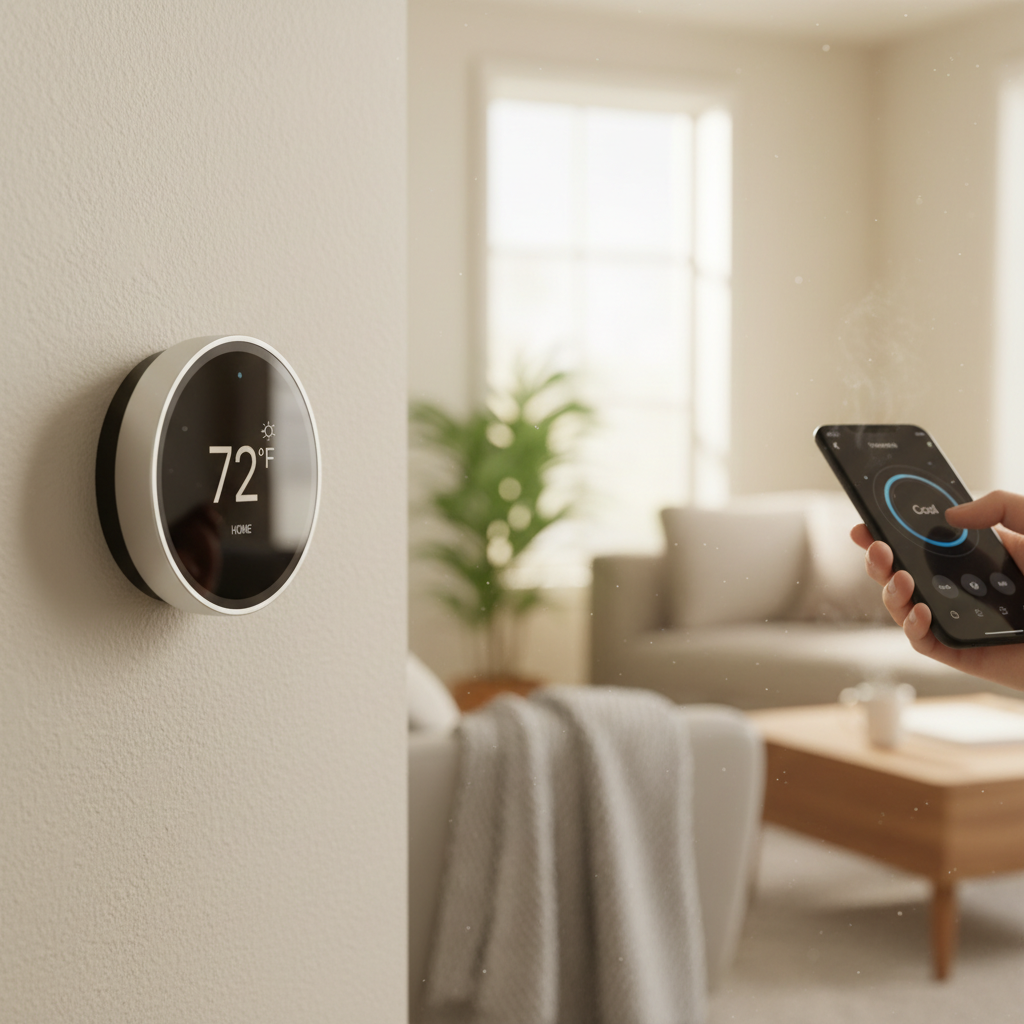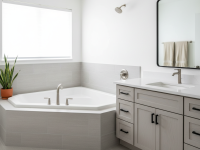Let’s be honest, we all love a comfortable home, right? A perfectly cozy temperature in winter, a refreshing coolness in summer. But what we don’t love are those eye-watering energy bills that arrive every month. For years, I struggled with trying to manually optimize my old, clunky thermostat, constantly fiddling with settings, and still feeling like I was throwing money out the window.
Then, I discovered the magic of smart thermostats. It felt like stepping into the future! Initially, the idea of installing one myself seemed daunting. Wires? Apps? HVAC systems? It sounded like a job for a professional. But after a bit of research and a leap of faith, I realized it’s genuinely a DIY-friendly project. And let me tell you, the comfort and savings I’ve experienced since have beeothing short of transformative.
If you’re tired of high energy bills and want to take control of your home’s climate with ease, you’re in the right place. This guide is born from my own journey – from being a total novice to confidently setting up and optimizing my smart thermostat. We’ll walk through everything, from choosing the right device to coecting the wires and fine-tuning its settings for maximum energy savings. Trust me, it’s easier than you think, and the payoff is absolutely worth it!
Why Even Bother with a Smart Thermostat?
You might be thinking, “My old programmable thermostat works just fine, why upgrade?” And yes, old programmable ones can *technically* set a schedule. But a smart thermostat is like upgrading from a flip phone to a smartphone – it’s a completely different league.
- Remote Control: Ever leave the house and wonder if you remembered to turn down the heat? With a smart thermostat, you can check and adjust your home’s temperature from anywhere using your phone. This alone has saved me countless kilowatt-hours.
- Learning Capabilities: Some models, like Nest, learn your habits. They figure out when you like it warm, when you’re usually away, and even how long it takes to heat or cool your home. It’s like having a personalized energy manager.
- Geofencing: This is a game-changer. Your thermostat knows when you’re leaving or arriving home based on your phone’s location. It can automatically turn down the system when you’re away and start warming/cooling before you get back, ensuring comfort without wasted energy.
- Energy Reports: Want to see exactly where your energy is going? Smart thermostats often provide detailed reports, showing you your usage patterns and offering tips for further savings. It’s empowering to see the data and make informed adjustments.
- Smart Home Integration: Many smart thermostats play nicely with other smart home devices like Alexa, Google Home, or even smart lighting. “Alexa, set the thermostat to 72 degrees” – pure convenience!
For me, the biggest win was the combination of remote access and geofencing. I used to blast the AC all day in summer to come home to a cool house. Now, my smart thermostat knows I’m heading home and kicks in just in time. Comfort, convenience, and a noticeable dip in my electricity bill – that’s why I bothered!
Choosing Your Smart Thermostat: Not All Are Created Equal
Before you dive into installation, you need to pick the right smart thermostat for your home and lifestyle. This isn’t a one-size-fits-all scenario, so a little homework here goes a long way.
Key Considerations:
- HVAC System Compatibility: This is crucial. Most smart thermostats work with conventional (forced air, heat pump) systems, but some older or more complex systems might require specific models or adapters. Check the product specifications and your existing thermostat’s wiring.
- C-Wire Requirement: Many smart thermostats require a “C-wire” (common wire) for continuous power. Without it, they might try to “power steal” from other wires, which can lead to system issues or inconsistent performance. Some brands offer a power extender kit if you don’t have a C-wire, but it adds an extra step to installation. Definitely check your existing wiring first!
- Features You Value: Do you want learning capabilities? Geofencing? Room sensors to balance temperature across your home? Integration with a specific smart assistant (Alexa, Google Assistant, Apple HomeKit)? Make a list of your must-haves.
- Design and Interface: While aesthetics aren’t everything, you’ll be looking at this device daily. Choose one that you find visually appealing and has an intuitive interface, either on the device itself or through its companion app.
I ended up choosing a model that had great geofencing capabilities and a robust energy reporting feature, as those were my top priorities for savings. Before purchasing, I actually pulled my old thermostat off the wall (after turning off the power, of course!) and took a picture of the wiring. This helped me confirm C-wire presence and match it against potential new thermostats’ compatibility lists.
Pre-Installation Checklist: Don’t Skip This!
Preparation is key, and taking a few minutes to get organized will make the installation process smooth and stress-free. Trust me, I learned this the hard way on my first attempt when I had to scramble for tools!
- Gather Your Tools: You’ll typically need a Phillips head screwdriver, a flathead screwdriver (sometimes for prying), wire labels (often included with the new thermostat, or masking tape works), a small level (also sometimes included), and your smartphone or tablet.
- READ THE MANUAL (or at least skim it): I know, I know. But seriously, each smart thermostat has its own specific instructions. Familiarize yourself with the general steps before you start.
- IMPORTANT! Turn Off Power: This is NON-NEGOTIABLE for your safety and to protect your HVAC system. Go to your circuit breaker panel and switch off the breaker that controls your furnace, air handler, or boiler. Don’t just rely on the thermostat’s “off” setting. Confirm the power is off by trying to turn on your old thermostat – it shouldn’t light up.
- Take a Picture of Your Old Wiring: This is your absolute best friend during installation. Take a clear, well-lit photo of how the wires are coected to your old thermostat’s terminals. This will be your reference point for coecting the new one. Label each wire if your new thermostat doesn’t come with pre-printed labels.
- Check for a C-Wire: Look at your old thermostat’s wiring. Is there a wire coected to a terminal labeled “C”? If so, great! If not, don’t panic. Some smart thermostats have workarounds, or you might need to install a power extender kit (PEK) which usually comes with the thermostat if it’s designed for C-wire-less systems.
The photo of my old wiring saved me from a lot of confusion. I remember staring at a spaghetti of wires, and that picture was my only anchor. Don’t skip this critical step!
The Installation Process: Easier Than You Think
Okay, deep breaths! We’ve done the prep work; now for the hands-on part. Remember, you’ve got this!
- Remove the Old Thermostat Faceplate: Gently pull the old thermostat’s faceplate away from its base plate, exposing the wires and terminals.
- Label the Wires: Carefully label each wire with the corresponding letter from the terminal it’s coected to (e.g., R, G, Y, W, C). Use the labels provided or masking tape. Double-check that your labels match your photo.
- Discoect the Wires: Use your screwdriver to loosen the terminal screws and carefully remove each wire. Make sure the wires don’t fall back into the wall! A bit of tape can help hold them in place if needed.
- Remove the Old Base Plate: Unscrew the old base plate from the wall. You might need to patch some old screw holes or paint if the new thermostat is a different size.
- Mount the New Base Plate: Thread your wires through the opening in the new smart thermostat’s base plate. Hold the new base plate against the wall, use your level to ensure it’s straight, and mark the screw holes. Drill pilot holes if necessary, then secure the new base plate to the wall.
- Coect the Wires to the New Base Plate: This is where your photo and labels become invaluable! Match each labeled wire to the corresponding terminal on your new smart thermostat’s base plate. Insert the bare end of each wire fully into its terminal and tighten the screw firmly, but don’t overtighten. Ensure no stray wire strands are touching other terminals. Pay special attention to the C-wire if you have one – it’s crucial for consistent power. If using a PEK, follow its specific wiring instructions here.
- Attach the New Thermostat Unit: Once all wires are securely coected, carefully snap or click the new smart thermostat’s display unit onto its base plate.
- Restore Power: Go back to your circuit breaker panel and switch the power back on.
That moment when the smart thermostat screen lights up for the first time? Pure satisfaction! It’s like breathing new life into your home’s control center.
Initial Setup and Configuration: Making It Smart
Now that your thermostat is physically installed, it’s time to teach it about your home and preferences.
- On-Screen Setup: The thermostat will likely guide you through an initial setup on its display. This usually includes selecting your language, confirming your HVAC system type (e.g., conventional, heat pump), and coecting to your home Wi-Fi network.
- Download the App: Download the smart thermostat’s companion app to your smartphone or tablet. Create an account and link your new device. This app is your command center!
- Location and Geofencing: If your thermostat supports geofencing, enable location services for the app and set up your home’s location. This allows it to know when you’re coming and going.
- Scheduling Your Comfort: Decide if you want to use the thermostat’s learning capabilities (if available) or create a custom schedule. I started with a custom schedule based on my family’s routine, then let the learning feature fine-tune it over time. Set your “away” temperatures to be a few degrees higher in summer and lower in winter than your occupied temperatures – this is where significant savings happen!
- Room Sensors (Optional): If you purchased additional room sensors, place them in rooms where you want to balance temperature or monitor occupancy. This is fantastic for homes with hot or cold spots.
Getting the Wi-Fi coected was a breeze, and setting up my initial schedule felt empowering. For the first time, I felt like I had intelligent control over my home’s climate.
Maximizing Your Energy Savings: Beyond Basic Setup
The initial setup gets you going, but true energy savings come from ongoing optimization. Think of it as tuning a high-performance engine.
- Understand Your Energy Reports: Most apps provide detailed energy usage reports. Look for patterns: when is your system working hardest? Are there “hot spots” or “cold spots” in your usage? This data is gold for identifying areas for improvement.
- Tweak Your Schedule: Regularly review and adjust your schedule based on your actual habits. Are you consistently away at a certain time? Make sure your “away” settings reflect that. Even a degree or two difference in your “setback” temperatures can add up to big savings.
- Embrace Geofencing: Don’t just set it and forget it. If your geofencing isn’t working perfectly, check your phone’s location settings and the app permissions. It’s a powerful tool for ensuring you’re only heating or cooling an empty house minimally.
- Utilize “Away” Modes: Whether manually activated or through geofencing, make sure your thermostat knows wheo one is home. These “away” temperatures are your biggest money-savers.
- Consider External Factors: Are you getting more sun on one side of the house? Is a window particularly drafty? Your smart thermostat can help compensate, but addressing these issues physically (e.g., blinds, weather stripping) will amplify your savings.
- Seasonal Adjustments: Don’t use the same schedule year-round. Optimize for summer (higher “away” temps) and winter (lower “away” temps).
My biggest “aha!” moment came from reviewing my energy reports. I noticed I was still ruing the AC higher thaeeded on certain days. A few simple tweaks to my schedule based on that data led to an even bigger drop in my bills. It’s an ongoing process of learning and adjusting!
Troubleshooting Common Hiccups
Even with the best instructions, sometimes things don’t go perfectly. Don’t get discouraged! Most common issues have simple solutions.
- Thermostat Not Powering On:
- Did you turn the power back on at the circuit breaker? (This happens more often than you’d think!)
- Is the C-wire (or PEK) correctly installed and coected?
- Are all wires securely seated in their terminals?
- HVAC System Not Responding:
- Double-check your wiring against your photo and the thermostat’s manual. A single misplaced wire can prevent operation.
- Confirm you selected the correct HVAC system type during the initial setup on the thermostat’s screen or app.
- Is your furnace/AC unit’s internal safety switch tripped? (Sometimes a quick power cycle at the breaker can reset it).
- Wi-Fi Coection Issues:
- Is your Wi-Fi password correct?
- Is your thermostat too far from your Wi-Fi router?
- Try rebooting your router.
I once had an issue where my AC wasn’t kicking on. Turned out I had accidentally swapped two wires. A quick check of my photo, a few minutes with a screwdriver, and everything was back to normal. Most problems are minor wiring or settings errors that are easily fixed.
Conclusion
Installing a smart thermostat might seem like a daunting task at first, especially if you’re not particularly tech-savvy or hands-on. But as I hope I’ve shown, with a bit of preparation and this step-by-step guidance, it’s a completely achievable DIY project. I went from being intimidated to feeling like a home automation pro, all while saving a significant amount on my energy bills and enjoying a more comfortable, responsive home.
The control, convenience, and crucial energy savings that a smart thermostat offers are truly game-changers. No more guessing, no more wasted energy, just smart, efficient climate control at your fingertips. So, take the plunge! Gather your tools, follow these steps, and get ready to transform your home’s comfort and your monthly budget. Your smart home journey starts now, with a smarter thermostat and a fatter wallet.




